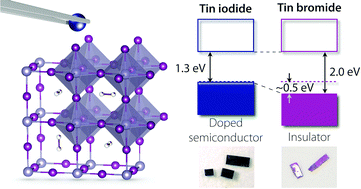|
Electrical properties of organic−inorganic hybrid tin bromide cubic perovskites: hole-doping and iodide substitution effects Hiroyuki Hasegawa and Tamotsu Inabe Abstract: Electrical properties of solution-grown organic−inorganic hybrid tin bromide perovskite crystals were evaluated. The resistivity of the as-grown crystal is 106−1010 Ω cm though hole doping of Sn(IV) results in a resistivity decrease by 1−5 orders of magnitude. The activation energy of the semiconducting regime was lower than the one expected on the basis of the band gap. This result suggests that the spontaneous doping as observed for the tin iodide system also occurs for tin bromide, although in this case the acceptor level is separated from the top of the valence band. Iodide substitution effects in tin bromide crystal were investigated using CH3NH3SnBr3(1−x)I3x (0 ≦ x ≦ 1) crystals with variable bromide/iodide ratio. The room temperature resistivity monotonously decreases with increasing iodide content, x. The behavior and optical properties can be explained by the band model in which iodide substitution lifts up the top of the valence band and makes the energy difference to the acceptor levels smaller. In addition, a negative differential resistance behavior was observed in the bromide-rich region. Graphical abstract:  10.1039/c6nj00439c |